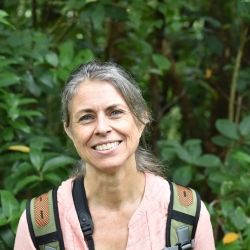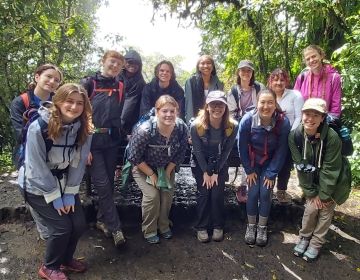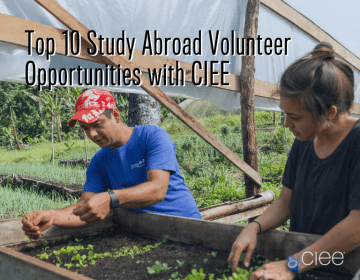Sustainability and the Environment: "Everybody Get Indigenous"
The second field trip was drawing to a close. I hope you like the last few chapters of books, because you're really in the thick of it now man. The adventurers left Giovanni's and embarked on the last leg of their journey, skirting the Panamanian border and setting their compass needles toward the indigenous communities of the Bri Bri. But the first thing they had to do before they did anything was to stop at the beach and play around in the waves for a little while, since this was Costa Rica and everything. What a nice way to break up the bus ride.
The adventurers try to learn everything from these oceans that they can
Now the old bus wasn't gonna be able to make it up into the Bri Bri community of Yorkin, which was where they were going, because the thing about Yorkin is it's super secluded, and there aren't even roads that go into it. Isn't that nifty? It was nifty, but what it really meant was that the adventurers had to get into these sweet canoes and get paddled up the the river by super strong local hombres.
Morgan, Julia, and Angela seem excited. Dan seems focused, which is also good.
Into the great unfolding of an antique mystery
Basically, the adventurers felt like they were in the beginning of The Road to Eldorado, when Miguel and Tulio are whacking their way through the jungle looking for the city of gold. Except the adventurers weren't looking for the city of gold; they were looking for indigenous communities that they could learn from with a plan to consider the ways in which the cultures and traditions of these communities could be preserved.
Yorkin is a beautiful, quaint, and secluded community with no cars or motorcycles, a few small footpaths, and very limited electricity. The Bri Bri people are very self-sufficient, relying on their traditional knowledge of the plants and animals to sustain them, and earning small amounts of money through tourism and the sale of art and chocolate.
The adventurers learn about medicinal plants and maybe eat one now and then
Evidently, this stuff was kind of sour. The photographer never tried it but he's guessing from their faces.
Maybe one of the best parts about Yorkin was the beautiful river that separated it from the other nearby Bri Bri communities. The adventurers made sure to take full advantage of this nice little slice of paradise by exploring its banks and sliding around down the rapids, which were only sort of rocky in a couple places.
Easing in and watching out for river sharks (note to concerned parents: no such thing as river sharks)
Julia loves it when she hits a rock while going down the water slide
Not only did the adventurers get to learn about the medicinal medicines and cultural heritage of the people of Yorkin, but they got to experience the process of making the famous Yorkin cacao, which is almost but not quite sort of like chocolate. It's super good stuff that everybody loves, and so to get a glimpse into the secret process was pretty once-in-a-lifetime if you know what I mean.
Sadia smashes the snot out of some cacao beans
Rachel grinds up said smashed beans while the other adventurers supervise to make sure she doesn't secretly eat it all
On their last day in Yorkin, it was time for a TCB lab activity, where the adventures divided themselves up into three groups to spread out all around the community and take on three different lab activities. One group measured tree diameters, another examined leaf litter insects, and the last group studied how different land uses affected the biodiversity of butterflies. The photographer followed the butterfly group, obviously.
Adam felt he had to disguise his group as butterflies so as not to scare away the butterflies, so he painted butterflies on them
Here's Adam explaining the Amanda and Erica how to use these nets
The team sampled butterfly species in an agroforest, a regenerating forest, and an undisturbed forest patch, in an effort to find out how these different land uses affected the biodiversity. It was a pretty sweet lab, mainly involving chasing butterflies all around the mountains, which is really all you can hope to get out of this life.
Ian's icy heart is thawed by the beauty of a butterfly (note to Ian's parents: he doesn't really have an icy heart)
Emma made a friend, and they even match
The adventurers take a break because the butterflies are starting to get suspicious
What a swell bunch of adventurers
And that was that; their time in Yorkin had drawn slowly to a close. The adventurers left this beautiful place as they had found it, but they could not help but worry for the future of the community. During their stay there, the adventurers witnessed the arrival of the first motorcycle to ever pass through Yorkin; on the back of it sat a Peace Corps volunteer and her local boyfriend. Things like this-- conflicting notions of "what's best" for the community, the disregard for preservation, the concept that anybody outside the community can hope to understand the Bri Bri better than they understand themselves-- spell imminent and impending change for the indigenous communities.
But change is what fuelled mutation, and mutation fuelled evolution, and evolution is what got us out of the water. So I suppose that when we ask ourselves "what's next" for these indigenous and shrinking communities, we should respond with the significant closing words of Dr. Seuss's Butter Battle Book: "We will see, son. We will see..."
The journey home
Related Posts
Happy Earth Day: Today and Every Day
Happy Earth Day! Every April 22, this global event comes around to remind us how precious our planet is, what sustainable efforts we can make to protect Earth, and that... keep reading
Top 10 Study Abroad Volunteer Opportunities with CIEE
Have you ever wondered if you could volunteer abroad? Perhaps you're looking into study abroad programs that provide international volunteer opportunities. If you’re itching to study abroad and truly make... keep reading
Recycling Internship with ADI San Luis
Written by Maya Peske (Cornell College), Internship in Sustainability and the Environment The road from San Luis up to Monteverde is well known by all of the people in the... keep reading



